Research and Conservation in Southern Sonora, Mexico
Tropical Deciduous Forest Gallery
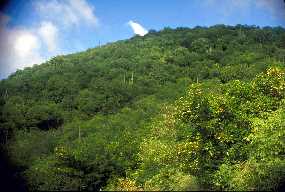 During the 3-month wet season, the tropical deciduous forest near Alamos receives about 30 inches (760 mm) of rainfall. The vegetation responds with lush foliage. Most of the columnar cacti are concealed beneath the tree canopy. Photo: Mark Dimmitt |
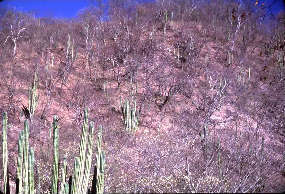 Late in the dry season (May-June) the tropical deciduous forest looks almost like desert. The abundant cacti are not concealed by tree canopies. Much their photosynthesis during the dry season with a peak in productivity just after the rainy season as leaves fall and open up the canopy. Photo: Mark Dimmitt |
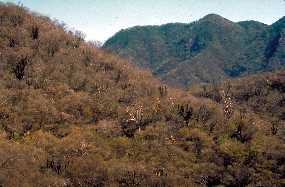 During much of the dry season tropical deciduous forest has a red-brown color that gives it one of its local names: monte mojino. Photo: C.D. Bertelsen |
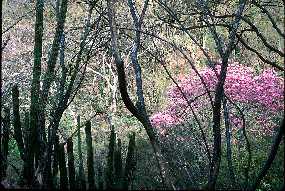 Many TDF trees flower during the winter-spring dry season. Amapa (Tabebuia impetiginosa) is one of the most spectacular. Photo: George M. Ferguson |
 Several species of palms occur in frequent groves throughout TDF. Palma (Brahea aculeata) near Sabanito Sur, Sonora. Photo: C.D. Bertelsen |
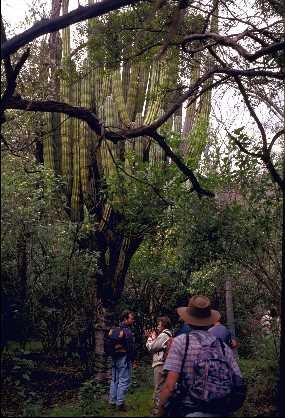 Even though this etcho (Pachycereus pecten-aboriginum) is very large, most TDF trees are taller, which is an informal criterion for distinguishing this forest from thornscrub. Photo: Mark Dimmitt |
 Tropical deciduous forest in summer. Near Alamos, Sonora. Photo: Mark Dimmitt |
 Dry rocky slopes in tropical deciduous forest have a thinner tree and shrub cover, and support smaller succulent species such as these amoles (Agave vilmoriniana). Río Guajaray, Sonora. Photo: Mark Dimmitt |
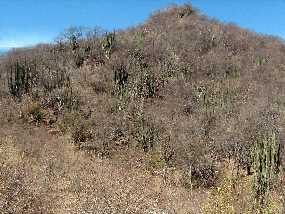 At the upper elevations of tropical deciduous forest etcho is replaced by sahuira (Stenocereus montanus). Palmaritas northeast of Alamos, Sonora. Photo: Mark Dimmitt |
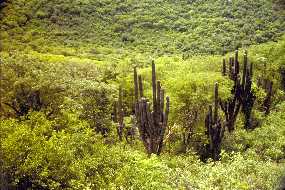 Tropical deciduous forest above San Bernardo, Sonora a week after the first rain in July. A few days earlier the scene looked as barren as the one at left. Photo: Mark Dimmitt |
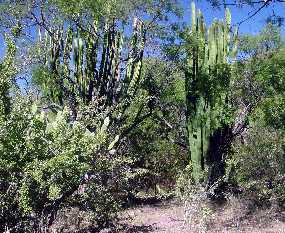 During the summer cacti such as etcho (left), sahuira (right), and prickly pear/nopal (Opuntia wilcoxii) are difficult to see among the foliage except at close range. Rancho Agua Salada near Alamos, Sonora. Photo: Mark Dimmitt |
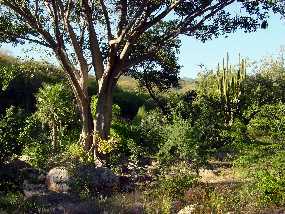 Near rivers figs (Ficus trigonata) and palms (Brahea aculeata) grow in close proximity to columnar cacti (Pachycereus pecten-aboriginum). El Cajón northeast of Alamos, Sonora. Photo: Mark Dimmitt |
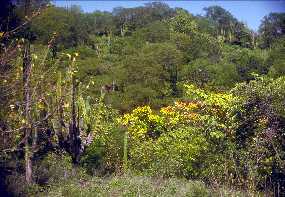 Within a week of the end of the summer rainy season in September, the most moisture-sensitive trees begin dropping their leaves. The yellowish tree here is cuajilote (Pseudobombax palmeri)., a relative of the kapok tree. Photo: Mark Dimmitt |
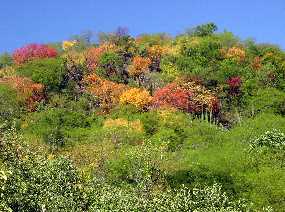 In some areas of tropical deciduous forest there is a good display of fall color. Most of the color in this image is from various torotes (Bursera spp.). Leaf-drop in TDF is an adaptation to drought, not to cold temperatures as in the temperate zone. MEX 16 east of Tónichi, Sonora. Photo: Mark Dimmitt |
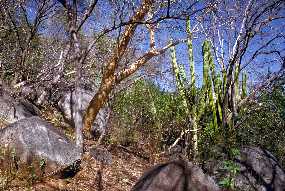 |
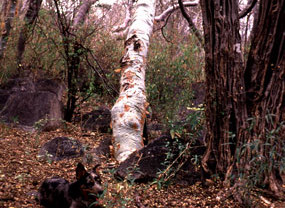 |
| Above two images: When leafless many tropical trees can be identified by their distinctive bark, though there is no botanical key available. | |
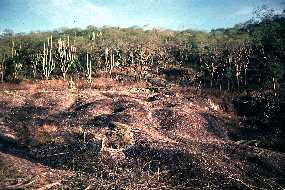 |
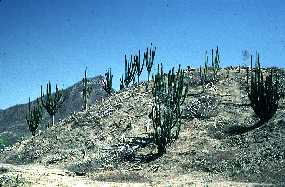 |
| Above two images: Large areas of desert, thornscrub, and tropical deciduous forest in Sonora have been cleared and converted to buffelgrass (Pennisetum ciliare) pastures. Buffelgrass is extremely competitive and invasive in the first two communities and the conversion is permanent. However, TDF will recover if the pasture is not maintained by grazing and burning (see image below left). Photos: T.R. Van Devender | |
| Chírahui or huinolo/boatthorn acacia (Acacia cochliacantha) is one of the few plants that can establish in a buffelgrass pasture. If not cut down, it will shade out the grass and in a few decades natural succession will restore healthy tropical deciduous forest. Alamos, Sonora. Photo: Mark Dimmitt |
 Ranchers leave islands of trees and cacti in cleared buffelgrass fields. They provide shade for cattle and wildlife, and provide a seed source for revegetation when the field is abandoned. This grove contains (l to r) garambullo (Celtis iguanea), tepeguaje, and etcho. Photo: Mark Dimmitt |
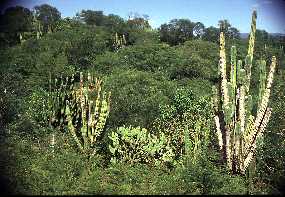 Tropical deciduous forest near Alamos, Sonora in full summer greenery. Photo: Mark Dimmitt |
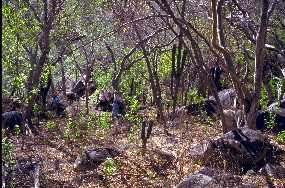 Tropical deciduous forest near Alamos, Sonora in March. It's early in the dry season and the partially deciduous canopy lets considerable sunlight into the forest floor. By June nearly full sun will be hitting the ground which will become very hot. From July to mid September the space beneath the dense canopy will be much cooler and more humid, a time of very high productivity. Photo: Mark Dimmitt |